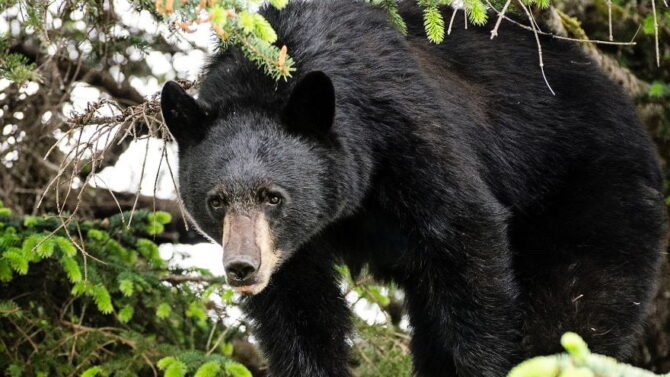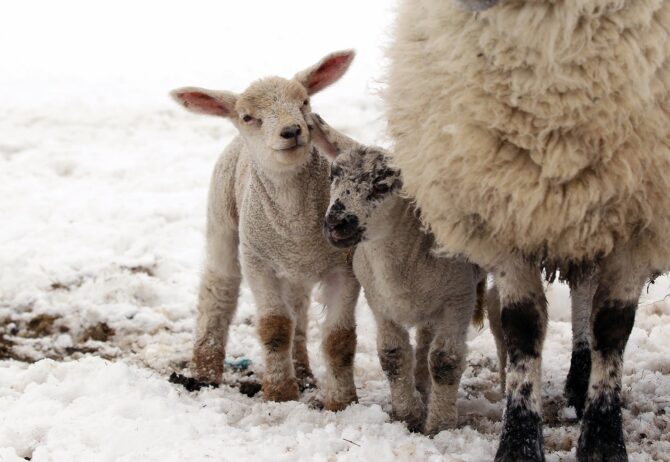It is all picturesque scenery of jungle-like valleys, canoe routes, hiking trails, and crystal lakes across virtually 5,000 square miles of Adirondacks in northeastern Upstate New York.
Remarkably, these landscapes are home to several animal species, including some that are ferocious or equipped with deadly defensive mechanisms.
Among the most dangerous animals in the Adirondacks are venomous rattlesnakes, coyotes, and black bears; however, you must also watch out for deer and bobcats.
These creatures can easily make an amazing and fascinating time in the Adirondacks a nightmare.
Hence, you need to take extra precautions and adhere to our safety advice for dealing with wildlife.
What are the Most Dangerous Animals in the Adirondacks?
1. Black Bears

- Scientific Name: Ursus americanus
- Classification: Mammal
- Habitat: Pacific Northwest’s forests and mountains
- Diet: Omnivore
- Conservation Status: Least Concern
The Adirondacks’ second-generation forests house black bears amongst the fifty mammal species in the region.
Black bears are potential threats to humans as they could raid campers within the region for food.
While they are incredibly big and often seem overweight, these enormous wild beasts are agile, fast, and adept with tree climbing and swimming.
Black bears can generate up to 800 PSI of bite force and a swipe force reaching 560 pounds; putting these figures into perspective, black bears are five times stronger than humans.
Black bears have a large appetite and would eat anything from berries, nuts, honey, and grains to insects.
Some of the bear’s diets are canned foods for humans, and its curiosity often leads it to human-inhabited areas, particularly where it can find such foods.
An unexpected black bear raid could be disastrous, as a human’s panic could be misinterpreted.
2. Deer

- Scientific Names: Cervidae
- Classification: Mammal
- Habitat: Rain forests, wetlands, grasslands, deciduous forests, arid shrublands, and mountains.
- Diet: Herbivore
- Conservation Status: Not extinct
You will most likely find a deer, particularly the white-tailed deer, through fields and forests or giddily crossing roads throughout the Adirondacks.
According to reports, an average of 65,000 deer-vehicle collisions occur in New York annually.
Therefore, the deer is not the kind of animal you want to encounter on the road, even if seeing one nibbling grass in your backyard might make you smile.
In the wild, bucks fight themselves as they look for does to mate.
Humans may not be the target, but getting caught up in a deer fight could lead to puncture wounds, bruising other forms of injury, or even fatality from a deer’s deadly antlers.
Does may also charge at you to protect their fawns if they feel you are a threat.
3. Moose

- Scientific Name: Alces alces
- Classification: Mammal
- Habitat: Boreal forests, temperate broadleaf, mixed forests
- Diet: Herbivore
- Conservation Status: Least Concern
You might be surprised to know that an adult moose has no known predators in the Adirondacks, putting a full-grown moose atop the food chain within the region.
We may attribute the Adirondack moose’s freedom to its size, as a bull moose can grow to 1,200 pounds.
While they are herbivores and do not prey on humans, the moose pose a more significant threat of attacking you within the Adirondacks because of their intimidating size.
They are big, reaching between five and 6.5 feet by shoulder height. Mature bulls are equipped with wide antlers of over six feet, which they use to attack to protect their calves or if they feel threatened.
4. Coyotes

- Scientific Name: Canis latrans
- Classification: Mammal
- Habitat: Oak savannah, woodlands, subalpine forests, temperate rainforests, deserts
- Diet: Carnivores
- Conservation Status: Least Concern
Coyotes have created a niche for themselves as the largest wild canine in the Adirondacks.
Therefore, it is not unusual to run into one, especially during the denning season when you can find them hunting during the day.
While coyotes are ready to back off when they encounter humans, they can become aggressive when humans interfere with their young and attack a hindered or injured person.
They may also become aggressive if they connect people and food, implying that you must remove or secure possible food sources, including garbage cans and pet food dishes, so coyotes can’t access them.
5. Raccoons
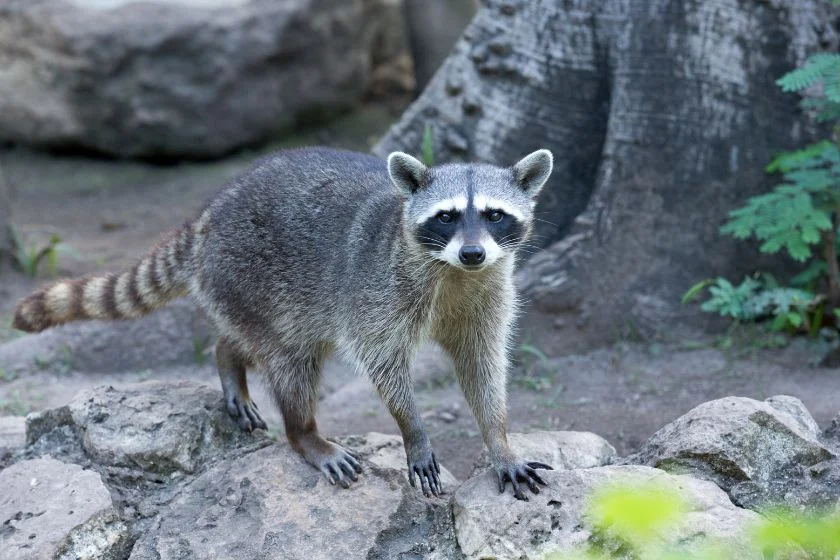
- Scientific Name: Procyon lotor
- Classification: Mammal
- Habitat: Moist woodland areas
- Diet: Omnivore
- Conservation Status: Least Concern
Raccoons are everywhere in the Adirondacks, especially where there is tasty trash for them to scavenge.
They often raid bins, animal cages, and pet food bowls to sustain themselves and could get into your camp to feast on your unsecured food or garbage.
It is best if you do not try not to frighten them as they can charge at you, bite, scratch, or hiss if threatened.
Nevertheless, they would not hurt anyone even though they can be curious and come close to you.
Raccoons are guilty of transmitting rabies, Leptospirosis, and raccoon roundworms that can infect people and pets.
They also cause life and property destruction by chewing wirings and damaging walls, ceilings, and woodwork.
6. Bobcats
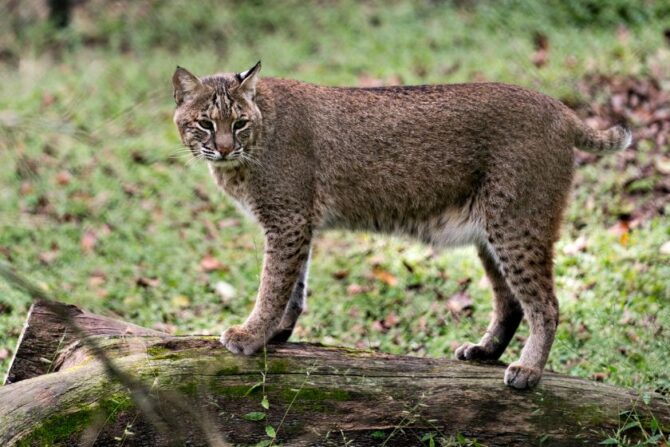
- Scientific Name: Lynx rufus
- Classification: Mammal
- Habitat: Coastal swamps, deserts, scrublands, hardwood forests, rocky areas
- Diet: Carnivore
- Conservation Status: Least Concern
Bobcats exist throughout the Adirondacks, making their homes rocky ledges or rock piles.
While they are barely two times bigger than a domestic house cat, bobcats eat rabbits and could prey on animals many times bigger than them, like deer.
As you may expect, bobcats do not prey on humans or even attack them; however, a nursing bobcat or a rabid one would have an extra urge to attack.
A rabid bobcat can infect a human with the rabies virus that causes severe brain or spinal cord inflammation and even death.
Bobcats are nocturnal animals that may attack your pet while you sleep if you are camping around the Adirondacks.
Like bigger wild cats, bobcats attack from a blind spot and could attack an unaware dog from behind or from a tree in the wild.
7. Fox

- Scientific Name: Vulpes vulpes
- Classification: Mammal
- Habitat: Mountains, deserts, forests, grasslands
- Diet: Omnivore
- Conservation Status: Least Concern
You can find two fox species in the Adirondacks — the red and grey fox. Foxes avoid humans at all costs and rather spend their time hunting smaller animals they prey on.
It would be wise not to use your knowledge about how this canine views humans to scare them, as they would attack if they feel trapped, cornered, threatened, injured, or sick.
Foxes also get rabid, and every fox bite must be treated as a rabid one due to the virus’s severity.
8. Porcupine

- Scientific Name: Erethizon dorsatum
- Classification: Mammal
- Habitat: Forests, deserts, grasslands
- Diet: Herbivore
- Conservation Status: Least Concern
The Adirondacks are home to these gentle creatures that can weigh almost forty pounds. In fact, the porcupine is the Adirondacks’ second-largest rodent.
As fascinating as porcupines are, we advise you to keep your distance from them as they are not shy to detach their spiky exteriors when curious hands get too close.
A porcupine’s quills should not be taken with the same levity as the thorn on an orange tree.
Why? These spiky hairs puncture the skin and move through muscle, eventually penetrating body cavities and internal organs and resulting in diseases like rabies or other infections.
Fortunately, porcupines are herbivores and cannot shoot their quills; they will stay out of your way if you steer clear of them.
9. Timber Rattlesnake
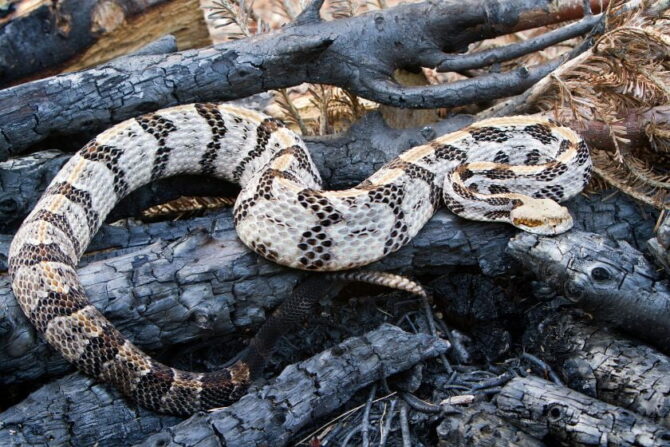
- Scientific Name: Crotalus horridus
- Classification: Reptile
- Habitat: Mountainous forests, hilly forests, agricultural fields, hardwood forests, lowland cane thickets, pine forests, swamps, river floodplains
- Primary Diet: Carnivore
- Conservation Status: Least Concern
The Timber Rattlesnake is a venomous pit viper you can find in the Adirondacks.
This rattlesnake is highly venomous, with an extremely potent, hemotoxic venom enough to kill a human.
Timber Rattlesnakes do not prey on humans but on rodents, birds, lizards, and amphibians.
Nevertheless, they would waste no time defending themselves if they feel threatened or cannot escape your unwelcome presence.
Adirondacks Wildlife Safety Tips
How can you refrain from enjoying the beauty of unsophisticated nature in the most untamed places? It would be a challenge, we suppose.
However, you can apply the following safety tips as you journey through the wild.
Keep pet food indoors
Wild animals like raccoons, coyotes and black bears may be drawn to pet food, prompting them to scavenge the area and raid your tent.
Therefore, it would be unwise to leave garbage or food remains around your tent or leave your pet’s food or food bowl where a scavenging wild animal can easily access it.
Stay away from forest tree lines
Gardening is satisfying, but that could be why you record frequent wild animal visits to your backyard.
Bears, deer, and foxes enjoy berries and other fruits and could be attracted to your fruit trees if they find them along forest boundaries.
Therefore, you must leave a fifty-yard gap between forest tree lines and your fruit trees.
Carry and learn to use bear spray
It would be best if you prepare yourself for possible bear attacks as you hike on the Adirondack trails, and using an aerosol bear spray is one of the most effective means.
Barring any other manufacturer’s instruction, point the canister at an aggressive bear and spray the contents for two to three seconds.
Bear sprays effectively deter a charging or aggressive bear from a distance of 1.5 to three meters.
Click here for more tips concerning preventing an encounter with black bears.
Never feed wild animals
Feeding wildlife is awful as diseases or parasites could spread at feeding sites. Their nutrition could be affected as well.
For example, a deer could suffer an acid imbalance in its stomach after consuming excessive corn.
Moreover, wild animals, regardless of their size, can inflict harm. Moose that humans feed lose their fear of humans and react aggressively towards them.
Beware of your posture
Wild animals are intimidating and tend to feel more confident when they sense a human’s fear.
Experts suggest that you stand tall and hold your arms out to look large to scare off wild animals if you have a face-to-face encounter with one.
You can make loud noises, throw objects, wave, and back off slowly when you face animals like coyotes, bears, foxes, raccoons, or bobcats.
It would be unwise to turn your back on wild animals as they are more comfortable attacking from behind.
Avoid overgrown areas
Refrain from stepping carelessly into overgrown bushes where snakes and other insects may hide, and observe trees, hills, and other elevated areas for bears, wolves, coyotes, and other animals.
Frequently Asked Questions
What is the apex predator in the Adirondacks?
Black bears sit atop the food chain in the Adirondacks, hunting smaller animals and eating berries. However, they have no natural predators in the wild.
Are there cougars in the Adirondacks?
While you may come across a cougar in the Adirondacks or see reports about annual cougar sightings, this region has no sustainable breeding population.
Most cougar sightings are isolated instances of escaped, released, or traveling cougars for specific purposes, including searching for a breeding partner.
Are there bears in the Adirondacks?
There are sustainable black bear breeding populations in the Adirondacks, inhabiting the extensive forest lands within this region.
Remarkably, over fifty percent of New York’s black bear population reside here and are a usual sight to hikers and campers, with approximately 4,000 in population.
Are there rattlesnakes in the Adirondacks?
Venomous snakes, including rattlesnakes, are uncommon in the Adirondacks. Still, you can find the Timber Rattlesnake in the lakeside rock formations.
Wrap Up
There is so much to see in the Adirondacks, but these most dangerous animals in the Adirondacks exhibit aggressive behaviors when they feel threatened.
Others, driven by their appetite or curiosity, may be dangerous to our pets or health as they interact with us in close proximity.
However, applying the safety tips, we have highlighted should keep you safe as you enjoy Adirondacks’ unbridled beauty.
